|
Tule
Ponds at Tyson
BIRDS
HERONS AND EGRETS |
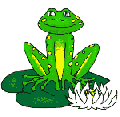 |
|
Great blue
herons and great and snowy egrets feed on fish, crayfish, frogs,
insects and rodents in shallow edges of open vegetation by wading
and stalking slowly, then lunging the beak quickly to catch prey.
In flight, their necks are held in an S-curve. They may make a
long glide when landing. They nest and roost in tall trees.
Most herons and
egrets have long plumes in breeding season. When they were hunted
almost to extinction in the late 1800s by plume hunters supplying
feathers for women’s hats, the Audubon Society was formed to
protect them. |
|
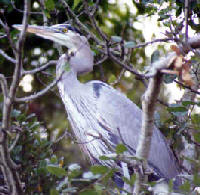 Great Blue Heron Great Blue Heron
Ardea herodius
RESIDENT
Adult great blue
herons stand about 4 feet tall in normal alert posture. They have a
large white head, long neck, and grayish body. They utter deep
rasping croaks as they fly away and slowly glide to a new location.
These birds have a black stripe above the eye extending into a tuft
of feathers at back of the head. The long, pointed, yellow bill is
used to spear fish and other prey. Commonly found in marsh, pond,
and creek habitats. |
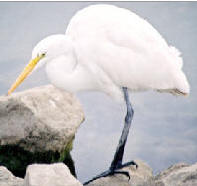 Great Egret Great Egret
Casmerodius
albus
A long yellow
bill and black feet distinguish the great egret. Its feathering is
all white. Adults have long plumes extending from the back to beyond
the tail in breeding season. Great egrets nest in colonies and build
their stick nests high up in trees. |
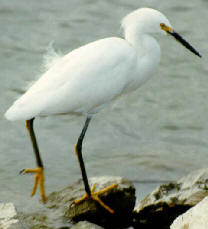 Snowy Egret Snowy Egret
Egretta thula
The snowy egret
has a black bill and black legs with golden “slippers”. In the
breeding season, adults have long plumes on the back, shorter ones
on the nape, and a crest on the neck. When stalking prey, the snowy
may spread its wings and stir the water beneath with one foot,
leaping after active prey. Dense colonies of snowies nest low in
trees, tules, or on marshy ground. The Snowy Egret is smaller than
the Great Egret. |
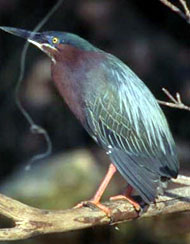 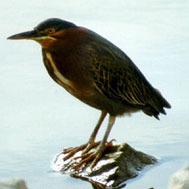 Green Heron Green Heron
Butorides
virescens
Adult green
herons are about the size of a crow. They fly with their long beaks
and legs extended. Adult green herons have distinctive bluish-green
and reddish-brown coloration. They forage along wooded shores from
perches on snags or trees close above the water. They build stick
nests in the upper dense tops of tall trees. |
|
Black-crowned
Night Heron
Nycticorax
nycticorax
The
black-crowned night heron has a stocky build with a thick neck and
head. Adults are whitish to pale gray except for the black cap and
bill. It has red eyes and yellowish legs. It spends the day in
dense tree canopies or clumps of tules and cat-tails and flies out
to feed at night. It is the most adaptable heron and is found in
lakes in city parks. |
|